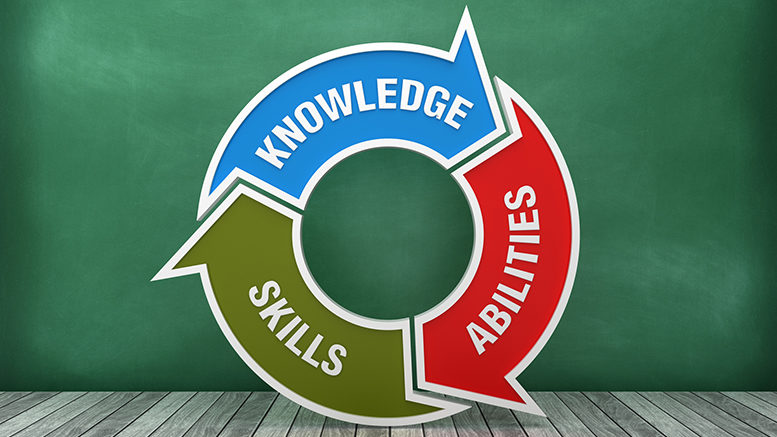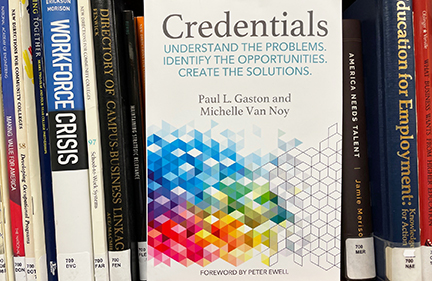“Credentials” is a long-established buzzword in workforce development, but it can mean a whole lot of different things in an ever-changing environment. Researchers Paul L. Gaston and Michelle Van Noy tackle the world of credentials — from promises and problems, to the differences among credentials and more — in their new book, Credentials: Understand the Problems. Identify the Opportunities. Create the Solutions. (Stylus Publishing, 2022).

Gaston is Trustees Professor Emeritus at Kent State University (Ohio), Distinguished Fellow at the Association of American Colleges and Universities, and a consultant to Lumina Foundation. He is one of the four original authors of the Degree Qualifications Profile (Lumina, 2011, 2015). Van Noy is an associate research professor in the Labor Studies and Employment Relations Department and director of the Education and Employment Research Center at the School of Management and Labor Relations at Rutgers, the State University of New Jersey.
Below, Gaston and Van Noy answer a few credentials-related questions posed by CC Daily.
The number and types of credentials offered by a widening variety of organizations continue to expand. What are the challenges for higher education institutions, particularly community colleges?
We believe that there are three broad challenges. First, colleges must assure themselves that the credentials they offer remain well aligned with student interests and employer needs–both current and emerging interest and needs. Second, colleges must describe the credentials and programs they offer more clearly, using terms transparent to students and employers. They should give particular attention (a) to articulating the learning outcomes their programs achieve and (b) to securing and sharing information on student success and ROI. Finally, colleges must strengthen and promote the guided pathways that lead to the award of the credentials they offer and be prepared to intervene when students “slip off the path.” A key goal of our book is to provide guidance to those struggling with these and other challenges associated with navigating the growing maze of credentials.
The general public has in recent years grown somewhat leery of the value of a college credential. Why is that?
There are several reasons for this growing skepticism. Increases in college costs have resulted in unprecedented levels of student debt, and far too many students drop out without earning a credential, many of them carrying student debt. At the same time, misalignment between some college credentials and employer needs have led employers to find fault with the preparation of the recent graduates they are hiring. And, abrupt closures of predatory for-profit providers have captured the headlines, further eroding trust in the system. The proliferation of the high number of college credentials that can have varying degrees of quality further complicates public trust. Confusion reigns and bad perceptions can rise to the top.
How has the world of credentials changed during the pandemic?
It’s difficult to predict the extent to which the changes seen during the pandemic will be sustained, there are arguably four areas where the impact of the pandemic appears likely to last. (1) An enforced migration from in-person classrooms to distance learning led both to improvements in online instruction and to an increasing level of comfort on the part of both students and faculty members. As a result, increased reliance on distance education is likely to continue. (2) Closely related, greater flexibility in how and where courses are offered should continue to prompt a broader variety of locations and schedules, many of them “hybrids.” (3) A third related phenomenon, the necessity for distance learning courses to articulate intended learning outcomes clearly and pursue them methodically, should translate into greater transparency for the curriculum as a whole. (4) Increased interest in short-term, non-degree credentials on the part of both students and institutions appears likely to continue as new combinations of such credentials and traditional degree programs continue to emerge.
As you state in the book, student advising has become more critical and the scope of what academic advisors should do is changing. Could you explain that in more detail?
Yes. Academic advisors increasingly are facing several responsibilities that either have emerged recently or that have become much more important. They must make themselves aware of a far broader range of educational opportunities available to students, most especially those offered by non-degree credentials. They must be willing to guide their advisees to the educational choices across credentials in a pathway which can require advisors to know and understand other providers. And given their on-the-ground awareness of emerging student interests and challenges, they must take a more active role in working with faculty to understand and appropriately advise on careers. They must also become aware of support services at the college and beyond to help connect students to resources that can help meet basic needs.
Do community colleges currently have strong partnerships with business and industry when it comes to developing credentials that lead to jobs and careers? If there is a disconnect, how can college leaders address it?
Relationships with business and industry are a key goal for community college workforce programs. They strive to collect labor market data and build relationships with local employers in ways that help inform program selection, content and delivery. Colleges are continuing to work on developing better approaches to using data and to effectively engage with employer advisory boards. College leaders must consider how to balance the needs and interests of students with those of employers to ensure students attain job-relevant skills while they are also able to pursue longer-term educational and career goals. Developing strong ties with industry requires ongoing effort and engagement.
Equity and diversity are top-line items for many colleges and companies. What role can credentials play in helping those organizations meet their equity and diversity goals?
We give particular attention to this question in Chapter 11, “Quality and Equity in the Credentials Marketplace.” We suggest, for example, (a) the disaggregation of student success data so as to reveal reasons for concern and opportunities for improvement, (b) an explicit merger of quality assurance with “equity assurance,” (c) the judicious exercise of governmental authority in support of the quality/equity agenda, (d) the use of a credential inventory to determine whether there may be overlooked opportunities to educate students facing challenges, and (e) the strengthening of academic advising to identify and overcome impediments to student success.
A discussion about non-credit programs: Michelle Van Noy will participate at the 2022 AACC Annual in a session on making non-credit programs a route to upward mobility. She will present national research concerning the number, nature, strengths and limitations of these programs. Register today.


